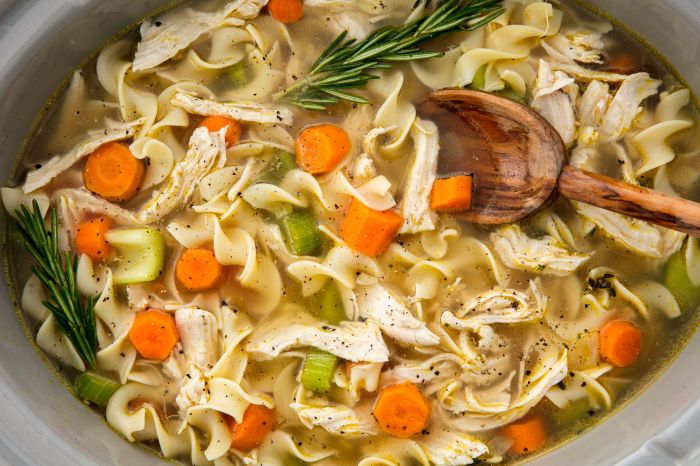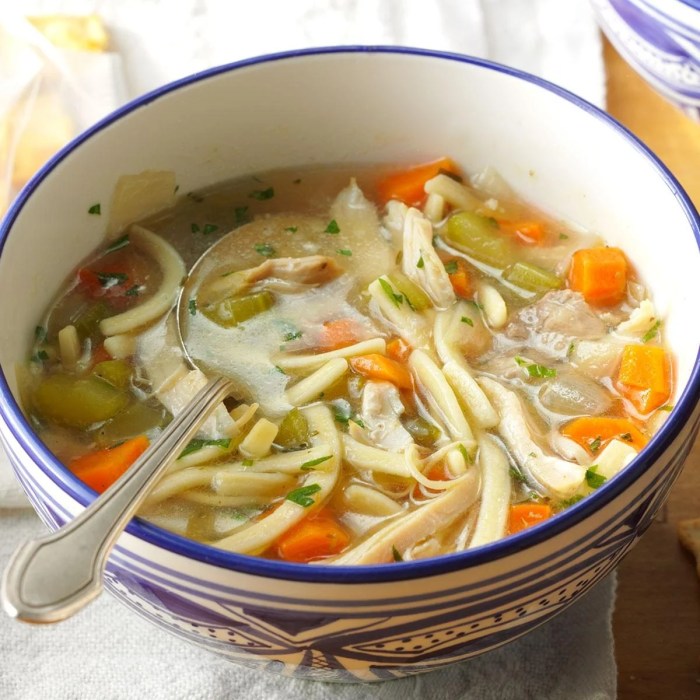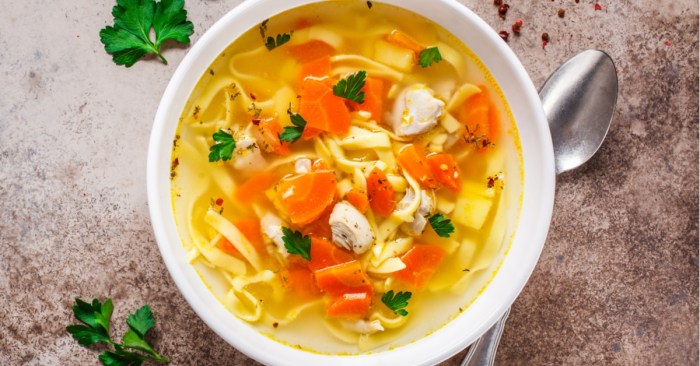Chicken Noodle Soup Recipe Variations: A Comparative Analysis: Chicken Noodle Soup Recipe For Sick

Source: hearstapps.com
Chicken noodle soup recipe for sick – Chicken noodle soup, a comforting classic, offers various iterations, each boasting unique flavor profiles and nutritional benefits. Understanding these variations allows for tailored recipe selection based on individual needs and preferences, particularly when catering to someone recovering from illness.
Recipe Variations: A Comparison of Three Chicken Noodle Soup Recipes
Three distinct chicken noodle soup recipes are compared below, highlighting variations in ingredients and their impact on the final product’s taste and nutritional value. Homemade broth is assumed unless otherwise specified.
| Recipe Name | Key Ingredients | Nutritional Highlights | Taste Profile |
|---|---|---|---|
| Classic Chicken Noodle Soup | Chicken broth, chicken breast, egg noodles, carrots, celery, onion, garlic, parsley | High in protein, good source of vitamins A and C | Savory, comforting, slightly sweet from carrots |
| Lemon Herb Chicken Noodle Soup | Chicken broth, chicken breast, rice noodles, carrots, celery, onion, garlic, fresh herbs (parsley, thyme, rosemary), lemon juice | High in protein, good source of vitamins A and C, antioxidants from herbs | Bright, herbaceous, slightly tangy from lemon |
| Spicy Ginger Chicken Noodle Soup | Chicken broth, chicken thighs, udon noodles, carrots, ginger, garlic, chili flakes, soy sauce | High in protein, good source of vitamins A and C, ginger’s anti-inflammatory properties | Savory, spicy, warming, umami from soy sauce |
The broth preparation significantly impacts the final soup. Homemade broth, simmered with chicken bones and vegetables, yields a richer, more flavorful base than store-bought options. Store-bought broths offer convenience but often lack the depth of flavor and nutritional complexity found in homemade versions. Noodle choice also influences the texture and nutritional profile; egg noodles provide a hearty texture, while rice noodles offer a lighter, more delicate alternative.
Udon noodles, with their thickness, add a satisfying chewiness.
A comforting chicken noodle soup recipe for sick days is easily adaptable to various preferences. For those seeking a hands-off approach, consider utilizing a slow cooker; you’ll find many helpful ideas on soup slow cooker recipes websites. This method allows for deeper flavors and less active cooking time, perfect for when you’re feeling under the weather and want a nourishing chicken noodle soup to aid your recovery.
Ingredient Selection and Preparation for Optimal Nutritional Value

Source: tmbi.com
Choosing high-quality, fresh ingredients is crucial for creating a nourishing and flavorful chicken noodle soup, especially for someone unwell. Prioritizing freshness ensures maximum nutrient retention and superior taste.
For the chicken, selecting free-range or organic options is ideal. To maximize flavor extraction and ensure tenderness, simmer the chicken in the broth for at least an hour, or until it easily shreds. Vegetables should be washed thoroughly and chopped to a consistent size for even cooking. Blanching vegetables before adding them to the soup can help preserve their vibrant color and nutrients.
- Select a whole chicken or bone-in chicken pieces for richer broth.
- Simmer the chicken in water with aromatics (onion, garlic, peppercorns) for at least 1 hour.
- Remove the chicken, shred the meat, and set aside.
- Wash and chop vegetables (carrots, celery, onion) into bite-sized pieces.
- Add vegetables to the broth and simmer until tender.
- Add noodles and shredded chicken to the soup, simmer until noodles are cooked through.
Dietary Considerations and Recipe Adaptations for Various Restrictions, Chicken noodle soup recipe for sick

Source: insanelygoodrecipes.com
Adapting the chicken noodle soup recipe to accommodate various dietary restrictions is straightforward. This ensures inclusivity and allows individuals with specific needs to enjoy this comforting meal.
- Gluten-free: Substitute egg noodles with gluten-free noodles (brown rice, quinoa, or lentil noodles).
- Dairy-free: Ensure the broth is dairy-free (check labels if using store-bought). Avoid adding any dairy products like cream or milk.
- Low-sodium: Use low-sodium chicken broth and reduce or eliminate added salt. Season with herbs and spices instead.
Always carefully check ingredient labels to confirm the absence of allergens and adjust seasonings to individual preferences. Communicating with the individual about their specific dietary needs and preferences is essential for creating a personalized and safe meal.
Serving and Presentation for Enhanced Appeal
Presenting the chicken noodle soup attractively enhances the overall dining experience. A visually appealing presentation can boost appetite, especially for someone who is unwell.
Serve the soup in a warm bowl, garnished with fresh herbs (parsley, chives), a squeeze of lemon juice, or a sprinkle of cracked black pepper. Maintaining the soup’s temperature is crucial; consider serving it in a pre-warmed bowl or using a thermos to keep it warm. For a blog post or recipe website, use descriptive language to evoke the senses: “The vibrant yellow of the carrots pops against the golden broth, while the fragrant steam carries hints of thyme and rosemary.”
- Serve in a warm bowl.
- Garnish with fresh herbs, lemon wedges, or a sprinkle of pepper.
- Maintain serving temperature using a pre-warmed bowl or thermos.
Nutritional Benefits and Therapeutic Properties of Chicken Noodle Soup
Chicken noodle soup’s therapeutic properties are widely recognized, particularly its role in supporting recovery from illness. Its nutritional composition contributes to hydration, immune support, and overall well-being.
The chicken provides high-quality protein, essential for tissue repair. Vegetables offer vitamins and minerals, while the broth contributes to hydration, crucial for combating dehydration often associated with illness. The soup’s warmth can be soothing, while certain ingredients, such as ginger, possess anti-inflammatory properties.
The vitamins and minerals in the ingredients contribute significantly to health. Vitamin A (from carrots) supports immune function, while vitamin C (from vegetables) acts as an antioxidant. The combination of ingredients provides a nutrient-rich meal, aiding in recovery.
Clarifying Questions
Can I use frozen chicken?
Yes, using frozen chicken is perfectly acceptable. Just ensure it’s thoroughly thawed before cooking to ensure even cooking.
How long can I store leftover soup?
Store leftover soup in an airtight container in the refrigerator for up to 3-4 days.
Can I make this soup in a slow cooker?
Absolutely! Slow cookers are ideal for this recipe. Adjust cooking times accordingly, typically 6-8 hours on low.
What are some other good garnishes?
Fresh herbs like parsley or chives, a squeeze of lemon juice, or a sprinkle of black pepper all add flavor and visual appeal.
